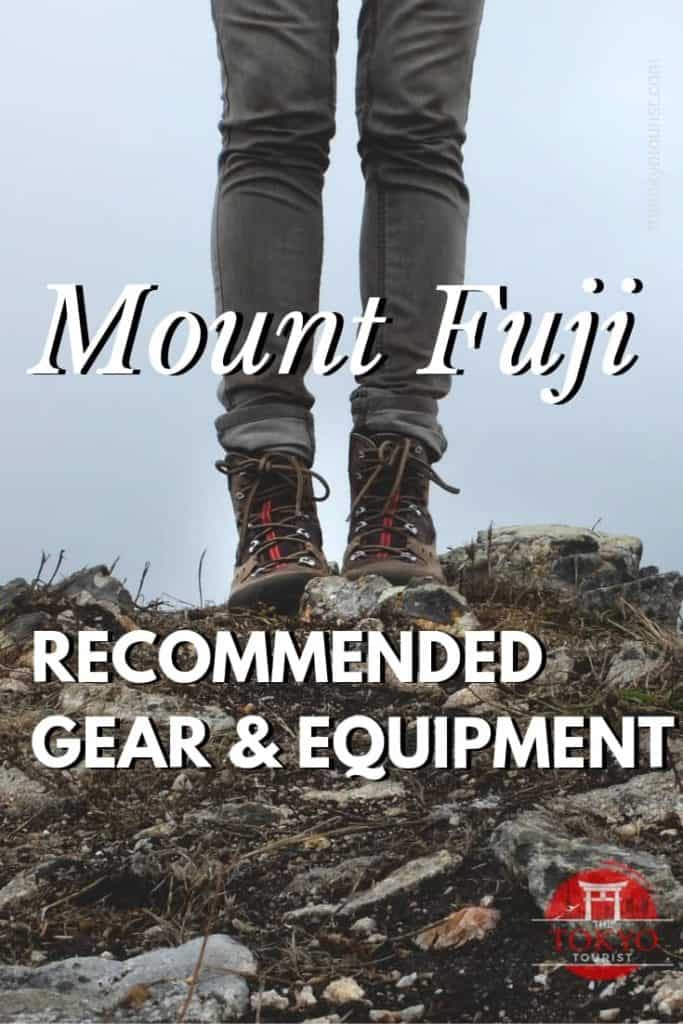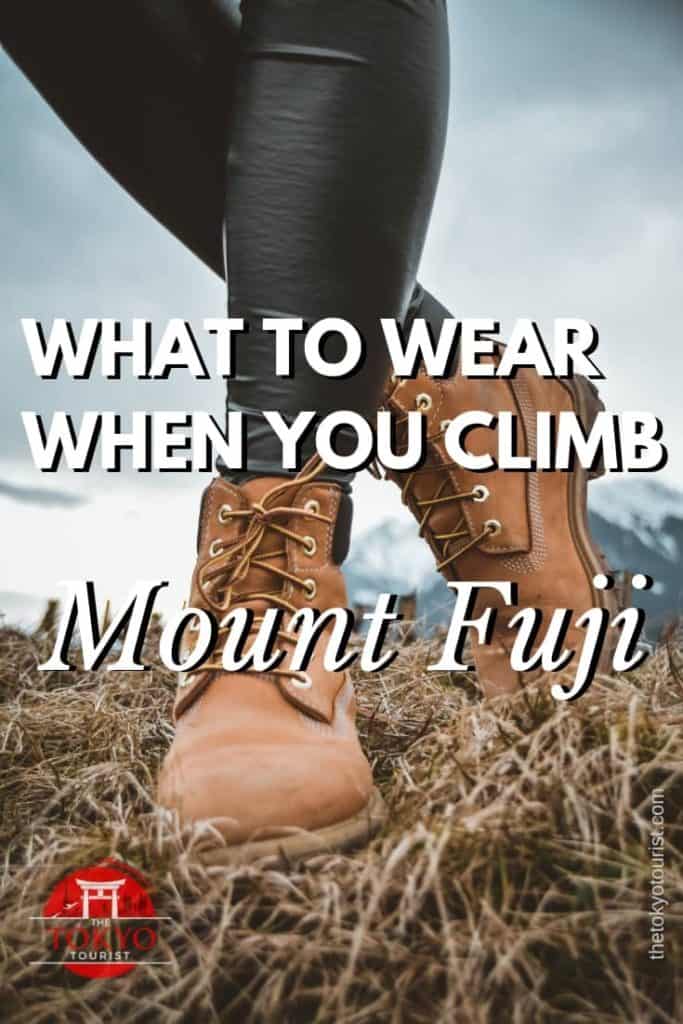Deprecated: mb_convert_encoding(): Handling HTML entities via mbstring is deprecated; use htmlspecialchars, htmlentities, or mb_encode_numericentity/mb_decode_numericentity instead in /home2/thetoky7/public_html/wp-content/themes/acabado/functions.php on line 2119
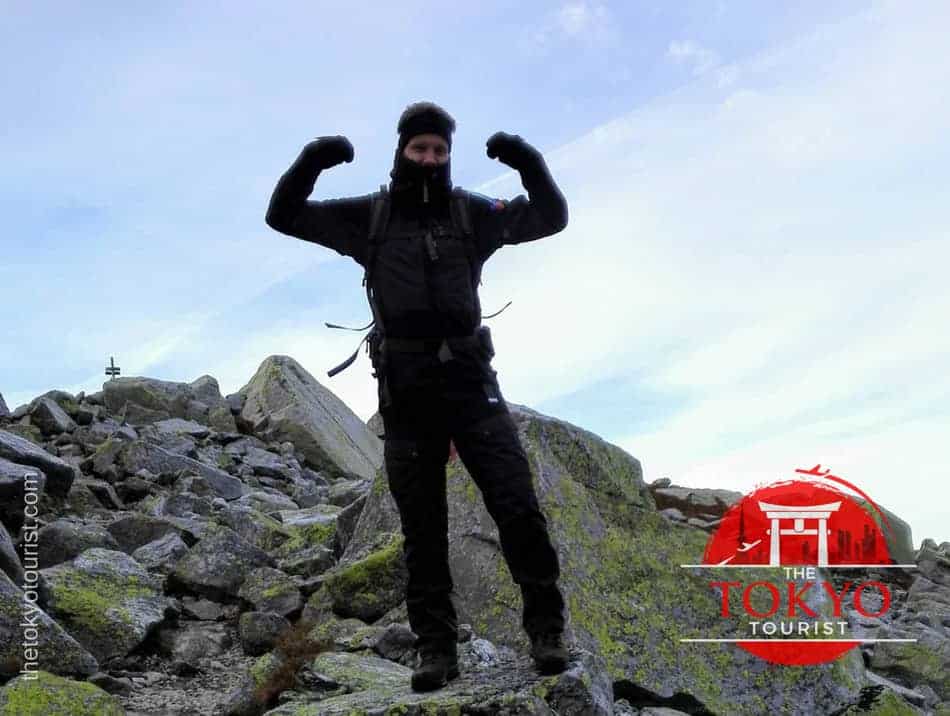
Gearing Up Before a Long Hike
You might be asking yourself: Do I really need a lot of fancy gear to climb Mount Fuji? That’s the wrong question. Instead ask yourself: How comfortable do I want to be when I climb Mount Fuji?
- What gear do I need to be happy walking for 10 hours in the pouring rain?
60% of climbers experience heavy rain. - What gear do I need to be comfortable in temperatures below freezing?
Temperatures of 27ºF (-3ºC) are common. - What gear do I need to be comfortable in wind speeds up to 60 mph (100 km/h)?
203 mph (328 km/h) is the record.
Packing list for Mount Fuji:
Check out the big fat Mount Fuji guide (opens in a new tab.)
Check out Recommended Equipment (opens in a new tab.)
Check out the list of stuff you don’t even know you need (opens in a new tab.)
Hiking Gear (Clothing)
I’ll only recommend gear I’ve personally tested and that works well for me. Since I (mostly!) wear men’s clothing that’s what I’ll be recommending. But if there’s a similar product designed for women I’ll be linking that as well. But keep in mind I’ve not tested the women’s products myself! And by the way, I love a good deal so I will not necessarily be recommending all the highest-end items. If it’s cheap, it works, and I like it I will recommend that product.
There are different clothing strategies. I like to be flexible with a good range of movement when I’m climbing. I also have a layered approach, so it’s easy to adjust between warm and cold weather. I’ll start from the bottom and work my way up.
If you don’t want to read all my yapping, you can scroll down to the condensed list at the bottom of the page.
Feet
Your feet are what’s going to carry you all the way to the summit, so they are the most important thing to get right.
Hiking Boots
I’ve seen people wear converse shoes and fail miserably. Walk an hour in the pouring rain with converse, and you’ll quickly see they’re not cut out for mountain climbing. You need sturdy hiking boots suited for this kind of terrain. Look for boots with:
- Anti-slip soles
- Good ankle support (it’s easy to twist an ankle on the lava rocks)
- Waterproof
- Lightweight or midweight
There are many good hiking boots an the marked. I currently use Meindl Kansas GTX. And the next pair I buy will be Meindl Kansas GTX. They’re not too expensive, and they check off all the important things like anti-slip, easy to clean, waterproof (Gore-Tex), extremely solid and very good ankle support. It’s also got a system to circulate the air, so your feet don’t overheat. Check prices on Amazon. There’s also a women’s version.
Socks
Hiking socks may seem expensive if you compare them to cotton socks where you pay $15 for a dozen. But remember proper hiking socks are made from costly and technical materials to ensure high performance. From all the hiking socks I’ve used Darn Tough Men’s Merino Wool Hiker Boot Sock is my favorite. It’s lightweight, fits well; it’s made from a merino wool blend which is a breathable material that keeps your feet fairly dry. And it’s reasonably priced. I’ve also used Dexshell Trekking Sock, but they are high-end and cost more so go for the Darn Tough socks if you want to save some money. They also have a women’s edition.
Lower Body
This is the way I usually dress for long hikes. I do it this way for maximum comfort and utility.
- Baselayer tights / long johns / thermal underwear – this is pretty much mandatory
- Hiking pants – should be windproof and water resistant
- (Waterproof over pants – you don’t wear these if it’s not raining)
Some people like to wear clammy rainwear even if it’s not raining. I hate it because it doesn’t breathe and it makes you crazy wet and warm (before you get cold).
Inner Layer (Lower Body)
Pay extra attention to what you wear closest to your skin. You need fabric that let’s sweat evaporate through the material. This helps you stay warm and dry. I like the Long Johns from Ridge Merino. It’s super lightweight and made 100% from merino wool, so it keeps you dry and warm. I enjoy the snug feeling. The women’s version is crazy colorful!
Take a look at this budget pick from Tesla. I haven’t tried it myself, but the ratings are good, and the price is even better. 🙂
Pro tip: Bring a spare baselayer (for lower and upper body). There’s nothing like changing into dry and clean clothes when everybody is freezing and stinking up the place.
Pants
There are a few schools when it comes to hiking pants! I like mine pretty windproof and water resistant. If you have waterproof they hardly breathe, and it makes you clammy, and I hate that feeling. I use three different types of hiking pants, all with their pros and cons.
- Fjallraven’s Keb Gaiter Trousers are nice because you can zip off the legs and convert it into a shorts. However, if it gets colder, it’s fast and easy to turn your shorts to pants again. They have plenty of room for a base layer. Very durable, water resistant and good against the wind. I also like the flexibility and the fit. If you want it even more water resistant, you can use Greenland Wax on it. It’s a really cool environmentally friendly wax impregnation you can use on Fjallraven’s G-1000 fabric. I use it for both pants and jacket. You can see me wearing those pants in the picture at the top of the page. There’s also a women’s version.
- If you don’t own hiking pants and you’re going to buy a pair only for this climb, I would recommend Singbring Outdoor Lightweight Waterproof Hiking Mountain Pants. They’re probably not as good as Fjallraven’s Keb Gaiter Trousers, but they’re about 1/5 of the price! This is a reasonable budget pick. Check out the price on Amazon.
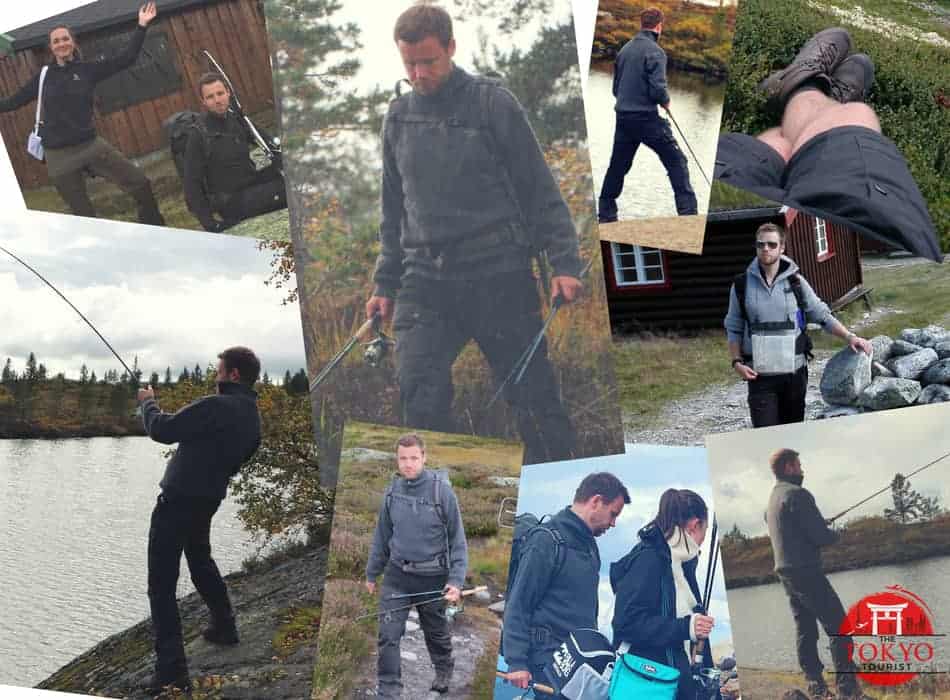
Rainwear
And finally the rainwear! Probably the most important piece of clothing you’ll be bringing. A complete rainwear set can cost anywhere from $40 to $400. I like rainwear you use over your normal gear, so I usually go for some cheap stuff. In my eyes, the rainwear’s first and foremost job is to keep you dry. Well, this cheap set keeps jo dry.
I have the SWISSWELL Rain Suit. It’s called a rain suit for men, but I think it’s pretty much unisex. It’s inexpensive (for its quality) just the way I like it. I bet there are quite a few inexpensive rainwear sets that will do the job, but I can testify to that the one from SWISSWELL does its job. Remember, you are using this over your hiking pants! Take that into consideration when you order.
Upper Body
I follow the same strategy for the upper body as the lower body.
- Baselayer long sleeve top – this is mandatory
- Windproof jacket with a nice hood
- (Waterproof over jacket – you don’t wear this if it’s not raining)
Inner Layer (Upper Body)
Again, pay attention to the fabric of your inner layer. I like merino wool because it keeps you dry and warm. I have more than ten long sleeve shirts, and the one from SmartWool is my absolute favorite. 100% merino wool, it doesn’t itch, it keeps me warm, and it’s got a zipper I can open when it’s hot. It also looks goods 🙂 Speaking of looking good, check out the women’s edition!
Jacket
The windproof jacket is probably the most expensive item, but the good thing is that you’ll be using it for many years to come. Since it’s an expensive item, I would go for something that looks good enough to wear in everyday life. For example, I never buy bright yellow or orange jackets. One thing I urge you to pay special attention to is the hood. A good hood really makes a big difference if it’s very windy.
In the photo at the top of the page, I wear a Fjallraven Keb Jacket. There’s an equally good woman’s version of it. It’s brilliant! I love it because:
- Holy sh*t, did you click the link and did you see that hood? It’s got string wire in it, and it’s like a protective cylinder for your head when the wind is strong.
- It’s water resistant and windproof
- It breathes very well
- Heck, you can even open it up on the sides to make it breathe even more
- The front pockets are great easy access
- It’s neutral looking. I can use it in everyday life even though it’s a high-end hiking jacket. If you buy a jacket and use it once a year, it’s indeed expensive. If you buy a jacket and use it 50 times a year, and on your long hikes for the next 10 years, it’s very cheap!
- Like with all of Fjallraven’s products with G-1000 fabric you can use Greenland Wax for better wax impregnation. I add some extra protection on my shoulders and hood before long hikes.
Sorry for the crappy PaintShop skills. My point is it’s very cozy inside that hood!
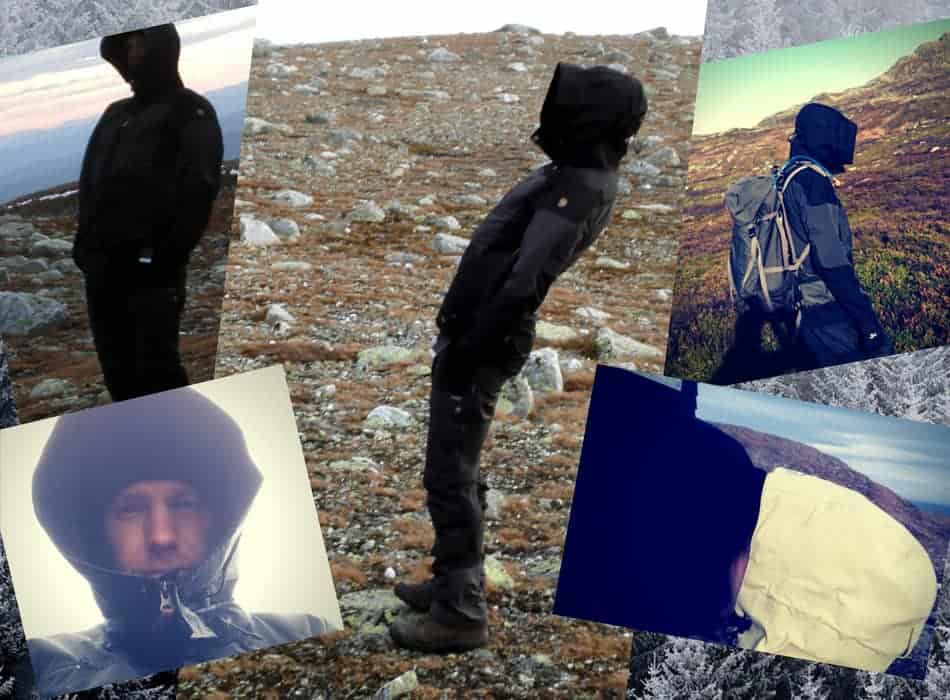
Hands
I like to bring two pairs of gloves because it sucks when your hands are cold! And when you have two pairs of gloves with you, you can combine them into three different options. A, B or A+B.
For it to be possible to wear two pairs of gloves at the same time one of the pairs needs to be really thin. Under Armour’s liner gloves are perfect! Super-thin, super-light, tight-fitting and amazingly warm to be so thin. And, lest not forget, you can use your touch screens with these gloves because of the awesome Tech Touch technology. This is typically the gloves you put on when it’s a bit nippy. They’re durable and very comfortable. I have the black ones. It makes me look like an agent. 🙂
And when it starts raining (and it probably will), you just pop on these (cheaper for women) puppies from reputable Mountain Hardwear. Windproof, water resistant, warm and durable. Perfect for climbing Mount Fuji, and perfect for a cold day back home.
Head
Got to protect that brain box from the elements. Or do you wear hats so your ears won’t fall off? I’m not sure! Anyway, it sucks not to have a hat when you walk for hours on hours in icy winds. For me, my ears tend to get cold before my head, so I like to wear a buff as a headband. When it gets colder just pull your buff down and use it as a scarf and then your warm hat on. This one is inexpensive, but it does the job in conjunction with the hood from the jacket Fjallraven Keb Jacket.
Now you got all your clothes for the hike. Check out the equipment you need.
Condensed List of Recommended and Tested Gear
- Head
- Upper Body – Inner Layer
- Upper Body – Jacket
- Fjallraven Men’s Keb Jacket (men)
- Fjallraven Women’s Keb Jacket (women)
- Gloves
- Lower Body – Inner Layer
- Lower Body – Pants
- Fjallraven Men’s Keb Gaiter Trousers (men)
- Fjallraven Women’s Keb Trousers (women)
- Budget pick: Singbring Outdoor Lightweight Waterproof Hiking Mountain Pants (men/women)
- Rainwear
- SWISSWELL Rain Suit (men/women) Remember to buy a size large enough to use over your normal hiking gear
- Hiking Boots
- Socks
Do you have any recommendations to add to the list?
Why not pin it for later? You can also follow the The Tokyo Tourist on Pinterest. 🙂


